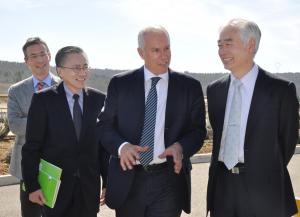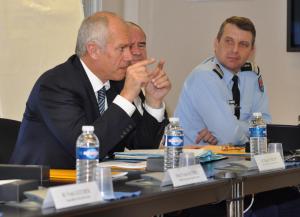PACA Region Préfet gets crash course on ITER
17 Mar 2011
-
Robert Arnoux
Préfet Hugues Parant took a crash course on ITER this Friday. He is seen here at the Visitors Centre with (left to right) Wouter van Baaren (Buildings & Site Infrastructure), Takayuki Shirao, Head of the Office of the Director-General, and Director-General Motojima.
In one of the interviews he gave to the media shortly after he was appointed Préfet of the Region Provence-Alpes-Côte d'Azur (PACA) five months ago, Hugues Parant stressed the importance of "going out in the field" and "seeing things for [him]self", before coming to any conclusion.
At ITER, this Friday, there was much that the Préfet de Région wanted to "see for himself".
For the head of the French administration in the PACA region and the government's High Representative, interest in a project the size of ITER goes with the job. In Mr Parant's case however, his interest was visibly more than just professional. There was a genuine curiosity about the science, the technology and the challenges of ITER.
The Préfet had come from Marseille the long way, following the ITER Itinerary all the way from Berre Harbour to the Cadarache site. The sky was perfectly clear and the view from the Gendarmerie helicopter must have been spectacular.
At the Château de Cadarache, where the helicopter landed, the Préfet was met by other members of the French administration (the Préfète of the Alpes-de-Haute Provence département, the Sous-préfets of Aix-en-Provence, Forcalquier and Brignoles, Gendarmerie General Mondoulet) as well as Carlos Alejaldre, Deputy Director-General of the ITER Organization; Jérôme Paméla, director of Agence Iter France; and CEA Deputy Director Michel Bedoucha. Mr. Parant and ITER Director-General Motojima were to meet later on at ITER Headquarters.
The French government's High Representative in the PACA region showed genuine interest in ITER science and technology. Sitting next to him are Gendarmerie General Mondoulet and Colonel Isoardi.
The crash course in ITER began with an overview of the French commitments to the project. Jérôme Paméla explained how funding and contributions to the project were organized, and described the component delivery process by way of the ITER Itinerary. "The first test convoy," he announced, "will be organized in September."
The Préfet insisted on the importance of communicating to the local population. "Transparency," he said, "is essential for the acceptability and success of the ITER Project."
Following the discussion, Mr. Parant and his party travelled to the ITER Headquarters, where they were met at the entrance by ITER Director-General Osamu.
As an introduction to his presentation, Director-General Motojima expressed his gratitude "for France's constant support and large contribution to ITER. Both are essential," he affirmed, "to the success of our project."
The Director-General defined ITER "as a fusion reactor and an energy amplifier" and stressed "the huge responsibility that we have to demonstrate the feasibility of fusion energy." The Préfet seemed surprised to learn that, "over 50 years, progress in fusion machines has been as fast and spectacular as in microprocessors."
Ken Blackler, Head of the Assembly & Operation Division, presents the model of the installation to the Préfet. Looking on are, from left to right: Michel Bedoucha, CEA-Cadarache Deputy-Director; Jérôme Paméla, director of AIF; Yvette Mathieu, Préfète of Alpes-de-Haute-Provence; Préfet Parant; DG Motojima and General Mondoulet.
Considering the present tensions on the energy front, the Préfet wondered if "the project could be boosted and the schedule accelerated." Deputy Director-General Carlos Alejaldre answered that, as far as ITER was concerned, about ten years were needed to complete construction of the installation which would then operate for twenty years. "However," he added, "strong political will could make it possible now to begin designing an electricity-producing machine."
Mr. Parant asked several questions (in fluent English as he was posted in the US for four years between 1989 and 1993) on the safety of the fusion process and the long-term prospects of fusion energy.
The visit ended with a bus trip trip to the site, where the French government's High Representative could confront the knowledge he had just acquired to the spectacular reality of the ongoing works.




